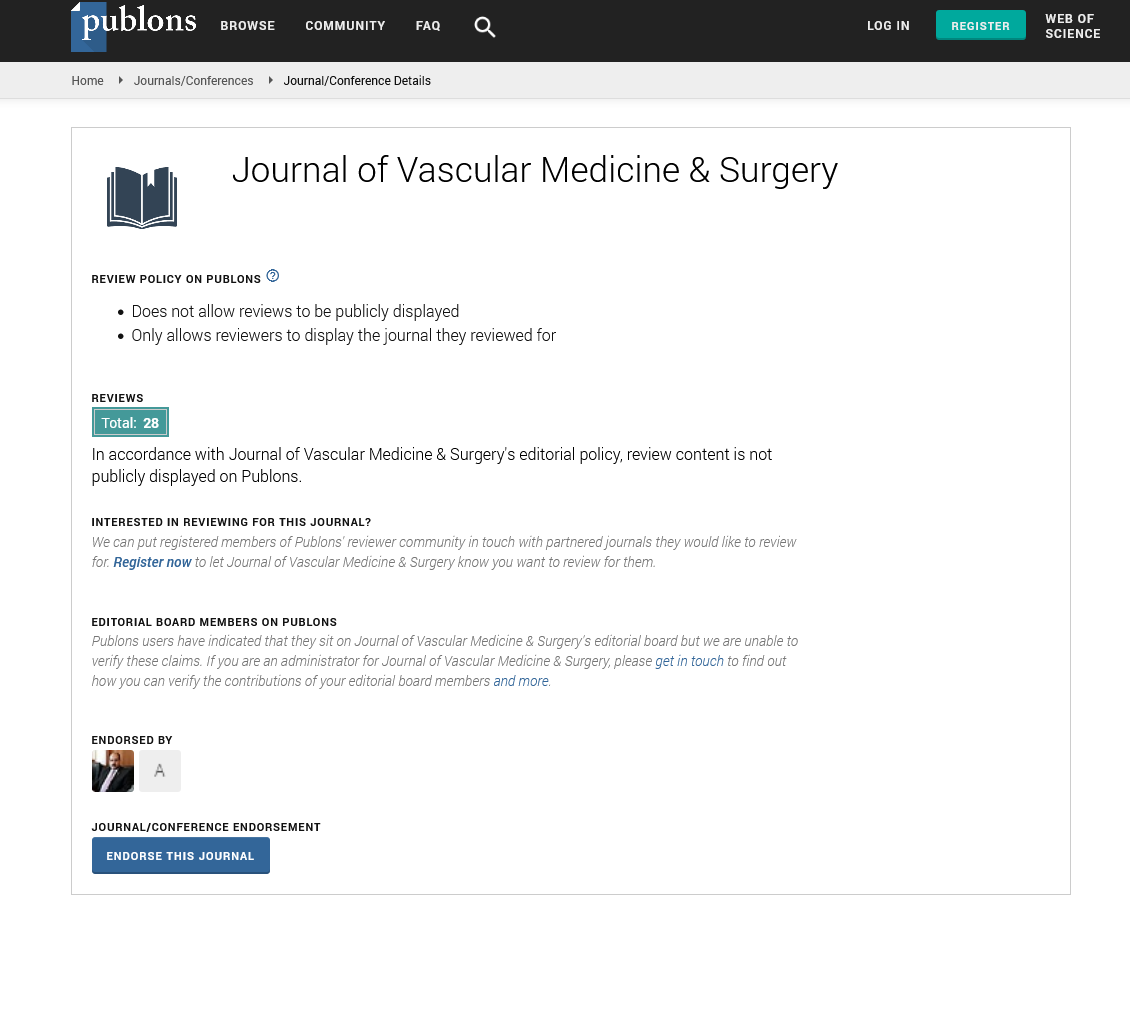Indexed In
- Open J Gate
- Academic Keys
- RefSeek
- Hamdard University
- EBSCO A-Z
- OCLC- WorldCat
- Publons
- Euro Pub
- Google Scholar
- SHERPA ROMEO
Useful Links
Share This Page
Journal Flyer

Open Access Journals
- Agri and Aquaculture
- Biochemistry
- Bioinformatics & Systems Biology
- Business & Management
- Chemistry
- Clinical Sciences
- Engineering
- Food & Nutrition
- General Science
- Genetics & Molecular Biology
- Immunology & Microbiology
- Medical Sciences
- Neuroscience & Psychology
- Nursing & Health Care
- Pharmaceutical Sciences
Perspective - (2024) Volume 0, Issue 0
The Impact of Thrombosis on Health: Symptoms, Types and Causes
James Bashir*Received: 25-Nov-2024, Manuscript No. JVMS-24-27719; Editor assigned: 27-Nov-2024, Pre QC No. JVMS-24-27719 (PQ); Reviewed: 11-Dec-2024, QC No. JVMS-24-27719; Revised: 18-Dec-2024, Manuscript No. JVMS-24-27719 (R); Published: 27-Dec-2024, DOI: 10.35248/2329-6925.24.S25.561
Description
Thrombosis is a medical disorder characterized by the formation of a blood clot or thrombus, within a blood vessel. This blood clot can block the flow of blood, potentially resulting in serious complications. Thrombosis is a major global health concern and can affect individuals of all ages.
Causes of thrombosis
Thrombosis occurs when the normal blood clotting mechanism, designed to prevent excessive bleeding, becomes dysregulated. Multiple factors can contribute to thrombosis formation, including.
Hypercoagulability: Certain medical conditions, such as cancer, pregnancy and genetic disorders including Factor V Leiden mutation, can increase the blood's tendency to clot.
Endothelial injury: Damage to the inner lining of blood vessels, known as the endothelium, can trigger clot formation. This can result from trauma, surgery or chronic inflammation.
Stasis of blood flow: Prolonged immobility, including a bed rest after surgery, can result in inefficient blood flow, increasing the risk of the development of blood clots.
Lifestyle factors: Smoking, obesity and a sedentary lifestyle are significant risk factors for thrombosis.
Medications and hormones: Oral contraceptives, hormone replacement therapy and certain medications can also raise the risk of thrombosis.
Types of thrombosis
Thrombosis is commonly categorized into two categories based on the location of the circulatory system clots.
Venous thrombosis: Deep Vein Thrombosis (DVT) occurs when a blood clot forms in the deep veins, generally in the veins of the legs. Symptoms include oedema, pain, inflammation and swelling of the affected limb. Pulmonary Embolism (PE) separate from a vein and travels to the lungs; it can cause a pulmonary embolism. Shortness of breath, chest pain and an increased heart rate are included in the symptoms. It is a significant physical condition that requires immediate medical intervention.
Arterial thrombosis: Arterial thrombosis occurs when a vein clot forms in an artery, preventing blood flow to the organs that require oxygen. This can lead to severe conditions such as heart attacks, strokes or peripheral arterial disease. Symptoms vary depending on the affected organ and can include chest pain, neurological deficits or limb pain.
Symptoms of thrombosis
The symptoms of thrombosis depend on its region and severity. Common signs include: Swelling, usually in one limb, pain or tenderness in the affected area, skin discoloration (redness or blue tinge) and shortness of breath or chest pain in cases of pulmonary embolism. Neurological symptoms, such as sudden weakness or speech difficulties, in arterial thrombosis. It is important to note that some cases of thrombosis may be asymptomatic, particularly in its early stages. Early detection requires frequent medical examinations of factors associated with risk.
Risk factors of thrombosis
Some people are more susceptible to thrombosis. Common risk factors include.
Age: Risk increases with age.
Genetic predisposition: A family history of thrombosis or inherited clotting disorders can raise the risk.
Chronic conditions: Diabetes, hypertension and autoimmune disorders such as lupus are associated with an increased risk.
Recent surgery or trauma: These can damage blood vessels and trigger clot formation.
Pregnancy and postpartum period: Hormonal changes and increased pressure on veins during pregnancy can lead to thrombosis.
Cancer: Certain cancers and their treatments elevate clotting risks.
Diagnosis of thrombosis
Thrombosis can be diagnosed by using a combination of medical history, physical examination and diagnostic procedures. Common diagnostic methods include: D-Dimer test measures the presence of fibrin degradation products, which are elevated in the presence of a clot. Doppler ultrasound is a noninvasive imaging technique commonly used to detect clots in veins. Computed Tomography (CT) or Magnetic Resonance Imaging (MRI) scans imaging modalities are particularly useful for detecting clots in the lungs, brain or other organs. Venography, also known as arteriography, is the process of introducing a contrast substance into blood veins to detect clots on X-rays. In some cases of suspected arterial thrombosis, echocardiogram test can help to assess heart function and detect clots.
Citation: Bashir J (2024). The Impact of Thrombosis on Health: Symptoms, Types and Causes. J Vasc Surg. S25:561.
Copyright: © 2024 Bashir J. This is an open access article distributed under the terms of the Creative Commons Attribution License, which permits unrestricted use, distribution and reproduction in any medium, provided the original author and source are credited.

